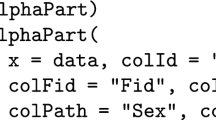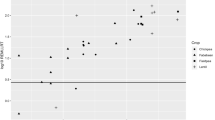Abstract
Key message
Probabilities of gene origin computed from the genomic kinships matrix can accurately identify key ancestors of modern germplasms
Abstract
Identifying the key ancestors of modern plant breeding populations can provide valuable insights into the history of a breeding program and provide reference genomes for next generation whole genome sequencing. In an animal breeding context, a method was developed that employs probabilities of gene origin, computed from the pedigree-based additive kinship matrix, for identifying key ancestors. Because reliable and complete pedigree information is often not available in plant breeding, we replaced the additive kinship matrix with the genomic kinship matrix. As a proof-of-concept, we applied this approach to simulated data sets with known ancestries. The relative contribution of the ancestral lines to later generations could be determined with high accuracy, with and without selection. Our method was subsequently used for identifying the key ancestors of the modern Dent germplasm of the public maize breeding program of the University of Hohenheim. We found that the modern germplasm can be traced back to six or seven key ancestors, with one or two of them having a disproportionately large contribution. These results largely corroborated conjectures based on early records of the breeding program. We conclude that probabilities of gene origin computed from the genomic kinships matrix can be used for identifying key ancestors in breeding programs and estimating the proportion of genes contributed by them.




Similar content being viewed by others
References
Bhosale SU, Rymen B, Beemster GTS, Melchinger AE, Reif JC (2007) Chilling tolerance of Central European maize lines and their factorial crosses. Ann Bot 100:1315–1321
Boichard D, Maignel L, Verrier E (1997) The value of using probabilities of gene origin to measure genetic variability in a population. Genet Sel Evol 29:5–23
Cox T, Lookhart G, Walker D, Harrell L, Albers L, Rodgers D (1985) Genetic relationships among hard red winter wheat cultivars as evaluated by pedigree analysis and gliadin polyacrylamide gel electrophoretic patterns. Crop Sci 25:1058–1063
Daetwyler HD, Wiggans GR, Hayes BJ, Woolliams JA, Goddard ME (2011) Imputation of missing genotypes from sparse to high density using long-range phasing. Genetics 189:317–27
Eding H, Meuwissen THE (2001) Marker-based estimates of between and within population kinships for the conservation of genetic diversity. J Anim Breed Genet 118:141–159
El-Kassaby YA, Cappa EP, Liewlaksaneeyanawin C, Klápště J, Lstibrek M (2011) Breeding without breeding: is a complete pedigree necessary for efficient breeding? PLoS One 6: e25737
Elshire RJ, Glaubitz JC, Sun Q, Ja Poland, Kawamoto K, Buckler E, Mitchell SE (2011) A robust, simple genotyping-by-sequencing (GBS) approach for high diversity species. PLoS One 6: e19379
Falconer DS, Mackay TFC (1996) Introduction to Quantitative Genetics, 4th edn. Addison Wesley Longman Limited, Harlow, p 58
Ganal MW, Durstewitz G, Polley A, Bérard A, Buckler ES, Charcosset A, Clarke JD, Graner EM, Hansen M, Joets J, Le Paslier MC, McMullen MD, Montalent P, Rose M, Schön CC, Sun Q, Walter H, Martin OC, Falque M (2011) A large maize (Zea mays L.) SNP genotyping array: development and germplasm genotyping, and genetic mapping to compare with the B73 reference genome. PLoS One 6(12): e28334
Gerdes JT, Behr CF, Coors JG, Tracy WF (1993) Compilation of North American maize breeding germplasm. CSSA, Madison
Gethi JG, Labate JA, Lamkey KR (2002) SSR variation in important US maize inbred lines. Crop Sci 42:951–957
Goddard ME, Hayes BJ (2009a) Genomic selection based on dense genotypes inferred from sparse genotypes. Proc Assoc Advmt Anim Breed Genet 18:26–29
Goddard ME, Hayes BJ (2009b) Mapping genes for complex traits in domestic animals and their use in breeding programmes. Nat Rev Genet 10:381–391
Gower JC (1966) Some distance properties of latent root and vector methods used in multivariate analysis. Biometrika 53:325–338
Graner A, Ludwig WF, Melchinger AE (1994) Relationships among European barley germplasm: II. Comparison of RFLP and pedigree data. Crop Sci 1205:1199–1205
Hayes BJ, Bowman PJ (2011) Accuracy of genotype imputation in sheep breeds. Anim Genet 43:72–80
Kimura M (1964) Diffusion models in population genetics. J Appl Probab 1:177–232
Kong A, Masson G, Frigge ML, Gylfason A, Zusmanovich P, Thorleifsson G, Olason PI, Ingason A, Steinberg S, Rafnar T, Sulem P, Mouy M, Jonsson F, Thorsteinsdottir U, Gudbjartsson DF, Stefansson H, Stefansson K (2008) Detection of sharing by descent, long-range phasing and haplotype imputation. Nat Genet 40:1068–1075
Lanner RM (2002) Why do trees live so long? Ageing Res Rev 1:653–671
Liu K, Goodman M, Muse S, Smith JS, Buckler E, Doebley J (2003) Genetic structure and diversity among maize inbred lines as inferred from DNA microsatellites. Genetics 165:2117–2128
Lorenz A, Hoegemeyer T (2013) The phylogenetic relationships of US maize germplasm. Nat Genet 45:844–845
Lübberstedt T, Melchinger AE, Dußle C, Marnik V, Kuiper M (2000) Relationships among early European maize inbreds: IV. Genetic diversity revealed with AFLP markers and comparison with RFLP, RAPD, and pedigree data. Crop Sci 40:783–791
Messmer MM, Melchinger AE, Lee M, Woodman WL, Lee EA, Lamkey KR (1991) Genetic diversity among progenitors and elite lines from the Iowa Stiff Stalk Synthetic (BSSS) maize population: comparison of allozyme and RFLP data. Theor Appl Genet 83:97–107
Messmer MM, Melchinger AE, Boppenmaier J, Brunklaus-Jung E, Herrmann RG (1993) Relationship among early European maize inbreds: I. Genetic diversity among Flint and Dent lines revealed by RFLPs. Crop Sci 32:1301–1309
Mikel MA (2008) Genetic diversity and improvement of contemporary proprietary North American dent corn. Crop Sci 48:1686–1695
Mikel MA, Dudley JW (2006) Evolution of North American dent corn from public to proprietary germplasm. Crop Sci 46:1193–1205
Montana G (2005) HapSim: a simulation tool for generating haplotype data with pre-specified allele frequencies and LD coefficients. Bioinformatics 21:4309–4311
Nelson PT, Coles ND, Holland JB, Bubeck DM, Smith S, Goodman MM (2008) Molecular characterization of maize inbreds with expired US plant variety protection. Crop Sci 48:1673–1685
Pausch H, Aigner B, Emmerling R, Edel C, Götz KU, Fries R (2013) Imputation of high-density genotypes in the Fleckvieh cattle population. Genet Sel Evol 45:3. doi:10.1186/1297-9686-45-3
Pritchard JK, Stephens M, Donnelly P (2000) Inference of population structure using multilocus genotype data. Genetics 155:945–959
R Core Team (2012) R: A Language and Environment for Statistical Computing. R Foundation for Statistical Computing, Vienna, Austria. http://www.R-project.org/, ISBN 3-900051-07-0
Rebourg C, Chastanet M, Gouesnard B, Welcker C, Dubreuil P, Charcosset A (2003) Maize introduction into Europe: the history reviewed in the light of molecular data. Theor Appl Genet 106:895–903
Romero-Severson J, Smith JSC, Ziegle J, Hauser J, Joe L, Hookstra G (2001) Pedigree analysis and haplotype sharing within diverse groups of Zea mays L. inbreds. Theor Appl Genet 103:567–574
Smith JSC, Chin ECL, Shu H, Smith OS, Wall SJ, Senior ML, Mitchell SE, Kresovich S, Ziegle J (1997) An evaluation of the utility of SSR loci as molecular markers in maize (Zea mays L.): comparisons with data from RFLPS and pedigree. Theor Appl Genet 95:163–173
Stich B, Melchinger AE, Piepho HP, Hamrit S, Schipprack W, Maurer HP, Reif JC (2007) Potential causes of linkage disequilibrium in a European maize breeding program investigated with computer simulations. Theor Appl Genet 115:529–536
Technow F (2012) hypred: simulation of genomic data in applied genetics. R package version 2
Technow F, Bürger A, Melchinger AE (2013) Genomic prediction of northern corn leaf blight resistance in maize with combined or separated training sets for heterotic groups. G3 3:197–203
Technow F, Schrag TA, Schipprack W, Bauer E, Simianer H, Melchinger AE (2014) Genome properties and prospects of genomic prediction of hybrid performance in a breeding program of maize. Genetics 197:1343–1355
van Heerwaarden J, Hufford MB, Ross-Ibarra J (2012) Historical genomics of North American maize. PNAS 109:12420–12425
Van Inghelandt D, Melchinger AE, Lebreton C, Stich B (2010) Population structure and genetic diversity in a commercial maize breeding program assessed with SSR and SNP markers. Theor Appl Genet 120:1289–1299
Wright S (1978) Evolution and genetics of populations, vol IV. The University of Chicago Press, Chicago
Acknowledgments
This research was funded by the German Federal Ministry of Education and Research within the Agro-Cluster “Synbreed—Synergistic plant and animal breeding” (grant 0315528D). We acknowledge the contributions of the late Prof. W.G. Pollmer and Dr. D. Klein in the development of the maize inbred lines analyzed in this study and grants from the University of Hohenheim for the development of the modern maize germplasm. We are indebted to Dr. Eva Bauer, Technische Universität München, for generating part of the SNP data used in this study under the “Cornfed” Project, supported by the German Federal Ministry of Education and Research (grant number 0315461). This paper is dedicated to one of the pioneers of biometrical methods in plant breeding, Prof. Dr. H. Friedrich Utz, on the occasion of his 75th anniversary.
Conflict of interest
The authors declare no conflict of interest.
Author information
Authors and Affiliations
Corresponding author
Additional information
Communicated by Natalia de Leon.
Rights and permissions
About this article
Cite this article
Technow, F., Schrag, T.A., Schipprack, W. et al. Identification of key ancestors of modern germplasm in a breeding program of maize. Theor Appl Genet 127, 2545–2553 (2014). https://doi.org/10.1007/s00122-014-2396-6
Received:
Accepted:
Published:
Issue Date:
DOI: https://doi.org/10.1007/s00122-014-2396-6




